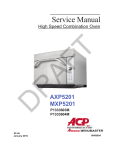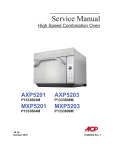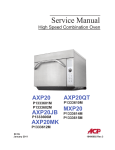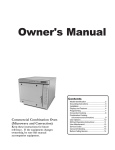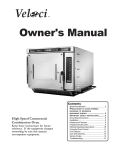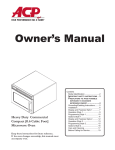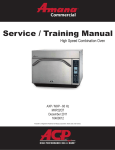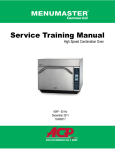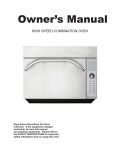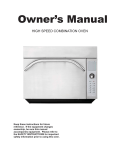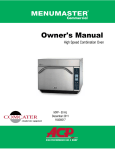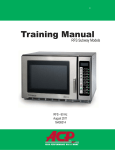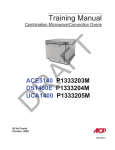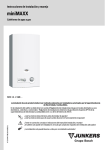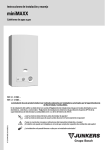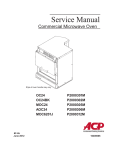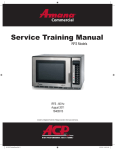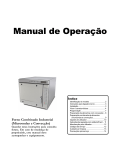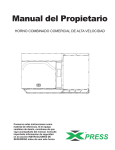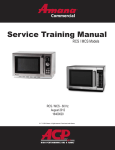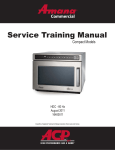Download Amana AXP520 Service manual
Transcript
______________ Service Manual High Speed Combination Oven AXP520 MXP520 P1333603M P1333604M 50 Hz June 2009 16400004 TABLE OF CONTENTS IMPORTANT INFORMATION .....................................................................................................1 IMPORTANT SAFETY INFORMATION ................................................................................. 2-5 Oven Specifications ...............................................................................................................6 Oven Construction............................................................................................................ 7-12 Oven Performance Test.................................................................................................. 13-14 Troubleshooting.............................................................................................................. 15-18 Display Diagnostics...............................................................................................................19 Service Test..................................................................................................................... 20-27 Touch Screen Calibration......................................................................................................28 Component Test Procedures ......................................................................................... 29-30 Quick Start Reference Guide.......................................................................................... 31-34 EZ Card Programming..........................................................................................................35 Wiring Diagram.....................................................................................................................36 Schematic Diagram...............................................................................................................37 Important Information Important Notices for Servicers and Consumers ACP will not be responsible for personal injury or property damage from improper service procedures. Pride and workmanship go into every product to provide our customers with quality products. It is possible, however, that during its lifetime a product may require service. Products should be serviced only by a qualified service technician who is familiar with the safety procedures required in the repair and who is equipped with the proper tools, parts, testing instruments and the appropriate service information. IT IS THE TECHNICIANS RESPONSIBLITY TO REVIEW ALL APPROPRIATE SERVICE INFORMATION BEFORE BEGINNING REPAIRS. ! WARNING To avoid risk of severe personal injury or death, disconnect power before working/servicing on appliance to avoid electrical shock. To locate an authorized servicer please contact: ComServ Support Center Web Site WWW.AMANACOMMERCIAL.COM ....................... Telephone Number 1-866-426-2621 or 319-368-8195 E-Mail: [email protected] Recognize Safety Symbols, Words, and Labels ! DANGER DANGER— Immediate hazards which WILL result in severe personal injury or death. ! WARNING WARNING— Hazards or unsafe practices which COULD result in severe personal injury or death. ! CAUTION CAUTION— Hazards or unsafe practices which COULD result in minor personal injury, product or property damage. 1 Important Safety Information ! WARNING Read the following information to avoid possible exposure to microwave radiation: The basic design of the Microwave Oven makes it an inherently safe device to both use and service. However, there are some precautions which should be followed when servicing the microwave to maintain this safety. These are as follows: 1. Always operate the unit from an adequately grounded outlet. Do not operate on a two-wire extension cord. 8. Do not for any reason defeat the interlock switches there is not valid reason for this action at any time; nor will it be condoned by ACP. 2. Before servicing the unit (if unit is operable) perform the microwave leakage test. 9. IMPORTANT: Before returning a unit to a customer, be sure to check for proper switch interlock action. 3. The oven should never be operated if the door does not fit properly against the seal, the hinges or hinge bearings are damaged or broken; the choke is damaged, (pieces missing, etc.); or any other visible damage can be noted. Check the choke area to ensure that this area is clean and free of all foreign matter. 10. The Microwave Oven should never be operated with any components removed and/or bypassed or when any of the safety interlocks are found to be defective, or when any of the seal surfaces are defective, missing, or damaged. 11. All microwave ovens meet all requirements of the radiation control for Health and Safety Act of 1968. Due to measurement uncertainties, the maximum leakage for the field will be 4mw/cm2. 4. If the oven operates with the door open and produces microwave energy, take the following steps: A. Tell the user not to operate the oven. B. Contact ACP ComServ immediately. 12. To ensure that the unit does not emit excessive microwave leakage and to meet the Department of Health and Human Services guidelines, check the oven for microwave leakage using a microwave oven leakage meter that complies with US Government CDRH / FDA / DHHS requirements and or any other local government requirements. The maximum leakage level allowed by ACP 2 is 4mw/cm . 5. Always have the oven disconnected when the outer case is removed except when making the "live" tests called for in the Service Manual. Do not reach into the equipment area while the unit is energized. Make all connections for the test and check them for tightness before plugging the cord into the outlet. 6. Always ground the capacitors on the magnetron filter box with an insulated-handle screwdriver before working in the high voltage area of the equipment compartment. Some types of failures will leave a charge in these capacitors and the discharge could cause a reflex action which could make you injure yourself. 13. If servicer encounters an emission reading over 4mw/cm 2, the servicer is to cease repair and contact the ACP ComServ Department immediately for further direction. ACP will contact the proper Government Agency upon verification of the test results. 7. Always remember that in the area of the transformer there is HIGH VOLTAGE. When the unit is operating keep this area clear and free of anything which could possibly cause an arc or ground, etc. 2 Important Safety Information Recognize this symbol as a SAFETY message ! WARNING When using electrical equipment, basic safety precautions should be followed to reduce the risk of burns, electrical shock, fire, or injury to persons. 1. READ all instructions before using equipment. 2. READ AND FOLLOW the specific “PRECAUTIONS TO AVOID POSSIBLE EXPOSURE TO EXCESSIVE MICROWAVE ENERGY”. 8. 9. This equipment, including power cord, must be serviced ONLY by qualified service personnel. Special tools are required to service equipment. Contact nearest authorized service facility for examination, repair, or adjustment. 3. This equipment MUST BE GROUNDED. Connect only to properly GROUNDED outlet. See “GROUNDING INSTRUCTIONS”. 10. DO NOT cover or block filter or other openings on equipment. 4. Install or locate this equipment ONLY in accordance with the installation instructions in this manual. 11. DO NOT store this equipment outdoors. DO NOT use this product near water, for example, near a kitchen sink, in a wet basement, or near a swimming pool etc. 5. Some products such as whole eggs and sealed containers, for example, closed glass jars may explode and SHOULD NOT be HEATED in this oven. 12. DO NOT immerse cord or plug in water. 13. Keep cord AWAY from HEATED surfaces. 6. Use this equipment ONLY for its intended use as described in this manual. Do not use corrosive chemicals or vapors in this equipment. This type of oven is specifically designed to heat or cook. It is not designed for industrial or laboratory use. 14. DO NOT let cord hang over edge of table or counter. 15. See door cleaning instructions in “Care and Cleaning” section. 7. As with any equipment, CLOSE SUPERVISION is necessary when used by CHILDREN . ! DO NOT operate this equipment if it has a damaged cord or plug, if it is not working properly, or if it has been damaged or dropped. 16. For commercial use only. CAUTION To reduce risk of fire in the oven cavity: a. DO NOT overcook food. Carefully attend equipment if paper, plastic, or other combustible materials are placed inside the oven to facilitate cooking. b. Remove wire twist-ties from paper or plastic bags before placing bag in oven. c. KEEP oven DOOR CLOSED , turn oven off, and disconnect the power cord, or shut off power at the fuse or circuit breaker panel, if materials inside the oven should ignite. Fire may spread if door is opened. d. DO NOT use the cavity for storage. DO NOT leave paper products, cooking utensils, or food in oven. SAVE THESE INSTRUCTIONS 3 Important Safety Information ! CAUTION To avoid risk of personal injury or property damage, observe the following: 7. Do not heat baby bottles in oven. 1. Briskly stir or pour liquids before heating with microwave energy to prevent spontaneous boiling or eruption. Do not overheat. If air is not mixed into a liquid, liquid can erupt in oven or after removal from oven. 8. Never use paper, plastic, or other combustible materials that are not intended for cooking. 9. When cooking with paper, plastic, or other combustible materials, follow manufacturer's recommendations on product use. 2. Do not deep fat fry in oven. Fat could overheat and be hazardous to handle. 3. Do not cook or reheat eggs in shell or with an unbroken yolk using microwave energy. Pressure may build up and erupt. Pierce yolk with fork or knife before cooking. 10. Do not heat sealed containers or plastic bags in oven. Food or liquid could expand quickly and cause container or bag to break. Pierce or open container or bag before heating. 4. Pierce skin of potatoes, tomatoes, and similar foods before cooking with microwave energy. When skin is pierced, steam escapes evenly. 11. To avoid pacemaker malfunction, consult physician or pacemaker manufacturer about effects of microwave energy on pacemaker. 5. Do not operate equipment without load or food in oven cavity. 6. Do not use regular cooking thermometers in oven. Most cooking thermometers contain mercury and may cause an electrical arc, malfunction, or damage to oven. PRECAUTIONS TO AVOID POSSIBLE EXPOSURE TO EXCESSIVE MICROWAVE ENERGY a. DO NOT attempt to operate this oven with the door open since open-door operation can result in harmful exposure to microwave energy. It is important not to defeat or tamper with the safety interlocks. c. b. DO NOT place any object between the oven front face and the door or allow soil or cleaner residue to accumulate on sealing surfaces. DO NOT operate the oven if it is damaged. It is particularly important that the oven door close properly and that there is no damage to the: (1) door (bent), (2) hinges and latches (broken or loosened), (3) door seals and sealing surfaces. d. The oven should NOT be adjusted or repaired by anyone except properly qualified service personnel. SAVE THESE INSTRUCTIONS 4 Important Safety Information ! Grounding Instructions WARNING ! Precautions to be observed before and during servicing to avoid possible exposure to excessive microwave energy, or electrical shock disconnect power to oven. Do not remove grounding prong when installing grounded appliance in a home or business that does not have three wire grounding receptacle, under no condition is grounding prong to be cut off or removed. It is the personal responsibility of the consumer to contact a qualified electrician and have properly grounded three prong wall receptacle installed in accordance with appropriate electrical codes. • Do not operate or allow oven to be operated with door open. • Make the following safety checks on all ovens to be serviced before activating the magnetron or other microwave source, and make repairs as necessary: • Interlock operation • Proper door closing • Seal and sealing surfaces (arcing, wear, and other damage) • Damage to or loosening of hinges and latches • Evidence of dropping or abuse • Before turning on microwave power for any service test or inspection within the microwave generating compartments, check the magnetron, waveguide or transmission line, and cavity for proper alignment, integrity, and connections. • Any failed or misadjusted components in the interlock, monitor, door seal, and microwave generation and transmission systems shall be repaired, replaced or adjusted by procedures described in this manual before oven is released to the consumer. • Check microwave leakage to verify compliance with the federal performance standard should be performed on each oven prior to release to the consumer. ! WARNING ! WARNING To avoid the risk of electrical shock or death, do not alter the plug. ! WARNING To avoid the risk of electrical shock or death, this equipment must be grounded. This equipment MUST be grounded. In the event of an electrical short circuit, grounding reduces the risk of electric shock by providing an escape wire for the electric current. This oven is equipped with a cord having a grounding wire with a grounding plug. The plug must be plugged into an outlet that is properly installed and grounded. Consult a qualified electrician or servicer if grounding instructions are not completely understood, or if doubt exists as to whether the equipment is properly grounded. WARNING Do not use an extension cord. If the product power cord is too short, have a qualified electrician install an appropriate receptacle. This oven should be plugged into a separate 50 or 60 hertz circuit with the electrical rating as shown in the appropriate drawing. Models operate with a 208 or 230 supply voltage. When an oven is on a circuit with other equipment, an increase in cooking times may be required and fuses can be blown. To avoid risk of electrical shock, injury or death; make sure these grounding instructions are followed. 5 SPECIFICATIONS Models Power Source Voltage AC Amperage (Single Unit) Frequency Single Phase, 3 wire grounded Receptacle Plug Power Output – Microwave Nominal microwave energy (IEC705) Minimum Temperature Rise (∆T) Operating Frequency Power Consumption Microwave only Convection fan Radiant heater Convection heater Combination Dimensions Cabinet (in / cm) Width Height Depth (includes bracket on back) Oven Interior (in / cm) – useable space Width Height Depth Weight (lbs. / kg) Uncrated Crated 6 AXP520 MXP520 P1333603M P1333604M 230/240 VAC 30 A 50 Hz X IEC 309 IEC 309 2200 Watts 22°F / 12°C 2450 MHz 5700 Watts 4200 Watts 425 Watts / 6200 RPM 3000 Watts 2000 Watts 5300Watts 25” 20 .25” 25.625” 63.5 cm 51 cm 65 cm 16.0” 7.75” 15.0” 41 cm 20 cm 38 cm 150 lbs. 175 lbs. 68 kg 79 kg OVEN OVENCONSTRUCTIONCONSTRUCTION PANELS (TOP & SIDE) Right Outer Panel Door AXP Air Filters Top Outer Panel Torx (T-15) Left Outer Panel Outercase Back Torx (T-15) 7 OVEN CONSTRUCTIONOVEN CONSTRUCTION CONTROL PANEL ASSEMBLY Control Holder Display Board Touch Screen Display Knob Collar Knob Touch Panel Assembly Bezel Data Key Board Data Key Board Holder Data Key Plug Caution: Do not handle touch screen display by the sides. This may damage the display circuitry. Handle using the corners. 8 OVEN OVENCONSTRUCTIONCONSTRUCTION Circuit Boards Power Relay Limiter Triac Thermocouple Temp Sensor (RTD) Cooling Fans Convection Motor Convection Motor Main Board *Relay Monitor Board *Power Relay Snubber Power Supply Board (24 VDC) Temp Sensor (RTD Radiant) Thermocouple Limiter Triac (TR4) -Radiant Heater Cooling Fans *Note: If Main Fuse (F1) is blown replace Relay Monitor Board, Power Relay & Interlock Switch Assembly. 9 OVEN CONSTRUCTIONOVEN CONSTRUCTION HV Transformers Magnetrons Fuses Sensor Triac’s Magnetron TCO’s Capacitor / Diodes High Voltage Transformers Temp Sensor (RTD Convection) Small Fuses F2,F3,F4 (12 amp) F2 - Convection Motor F3 - Magnetron # 1 F4 - Magnetron # 2 Switch (Primary) Capacitor Diode (Right Side) Triac (TR1) (Magnetron # 1) Triac (TR2) (Magnetron # 2) Triac (TR3) (Convection Heater) Magnetron # 1 Large Fuses F1,F5,F6 (25 amp) Magnetron TCO’s Magnetron # 2 Capacitor Diode (Left Side) *F1 - Main Fuse F5 - Convection Heater F6 - Radiant Heater *Note: If Main Fuse (F1) is blown replace Relay Monitor Board, Power Relay & Interlock Switch Assembly. 10 OVEN CONSTRUCTIONOven Switch Replacement & Interlock Switch Adjustment Switch Adjustment Lever Attach Ohm-Meter to Wire Harness Connectors Adjustment Figure 1 Mounting Screw Switch Test: When the door is opened or closed, the left door hinge activates the secondary / monitor switches. 1. Connect an ohm-meter to wire harness (as shown in figure 1, to verify switch activation). Note: The switch assembly should activate when the door gap is approximately 1/4 inch (6mm). Switch Adjustment: .tT verif 1. Loosen mounting screws. 2. Slide adjustment lever for proper switch activation. 3. Tighten mounting screws. 4. Preheat oven to set temperature and verify switch adjustment settings and function. Note: To ensure proper switch adjustment, the switch mounting MUST be tightened after each adjustment prior to testing the door alignment. Replacement Removal: NOTE: The switch assembly should activate when the door 1. Remove switch assembly mounting screw. 2. Push switch assembly 1/2 inch (13mm) towards back of oven. 3. Twist mounting leg towards oven cavity to release mounting tab. 4. Push assembly towards back of oven to remove. Note: New replacement switch assembly has been adjusted at the factory, no adjustment should be necessary. Mounting Leg Mounting Screw 11 OVEN CONSTRUCTIONAntenna Motor Cam Gear Assembly Antenna Rivet, Plastic See Detail Below *Note: Plastic Rivet cannot be reused. Antenna Motor Cam Rivet, *Plastic Gear Assembly Alignment Arrows Antenna 12 OVEN PERFORMANCE TEST Note: To run Oven Performance Test the, oven cavity must be at room temperature, and the display must read MICROWAVE ONLY mode. See below using oven as a microwave oven. If MICROWAVE ONLY is not in display you must go to User Options and activate MICROWAVE ONLY option. Changing User Options: 1. Oven must be OFF. 2. Press and hold Pad "2" for 5 seconds. KEYPAD 3.Rotate dial to highlight: ALLOW MICROWAVE ONLY mode. 4. Press SAVE. PREHEAT MENU USING OVEN AS A MICROWAVE OVEN This option is only available if the oven cavity temperature is less than 200°F. When user option MICROWAVE ONLY is set as a default, the MICROWAVE ONLY button appears on the PREHEAT MENU. See page 14 for Oven Performance Test procedure. To run Performance Test using microwave only follow these steps: 1. Place filled test bowl in oven. 2. Press MICROWAVE ONLY button. 3. Press manual cook. 4. Press Pad 3 twice for 33 seconds. 5. Press Start. 6. Oven will beep, remove test bowl from oven. 7. Press OFF to return to PREHEAT MENU. 13 OVEN PERFORMANCE TEST All Amana and Menumaster microwave oven power outputs are rated using the IEC705 standards. Using the IEC705 test method requires precision measurements and equipment that is not practical to be performed in the field. Using the test shown below will indicate if the oven performance is satisfactory. Test equipment required: • • 1000 ml test container and thermometer. Digital watch / watch with a second hand for use on ovens with electromechanical timers. Important Notes: • • • Low line voltage will cause low temperature rise / power output. Ovens must be on a dedicated circuit, properly grounded, and polarized. Other equipment on the same circuit may cause a low temperature rise / power output. This test and results are not a true IEC705 test procedures and are only intended to provide servicers with an easy means of determining if the microwave oven cooking output is correct. Procedure 1. Fill the test container to the 1000 ml line with cool tap water. NOTE: Water temperature should be approximately 60°F / 16°C 2. Using the thermometer, stir water for five to ten seconds; measure, and record the temperature (T1). 3. Place test container of water in the center of oven cavity and close door. 4. Heat the water for a 33-second full power cycle. NOTE: Use a digital watch or a watch with a second hand for ovens with electromechanical timers. 5. At end of the cycle, remove test container. Using the thermometer, stir water for five to ten seconds and record temperature (T2). 6. Subtract the starting water temperature (T1), from the ending water temperature (T2) to obtain the temperature rise (∆T). 7. If the temperature rise (∆T) meets or exceeds the minimum, the test is complete. If the temperature rise (∆T) fails to meet the minimum temperature rise, test the line voltage to verify it is correct. Then repeat steps 1-6 making sure to change the water. If the temperature rise (∆T) fails to meet the minimum temperature rise again the oven will require service. Minimum Temperature Rise at Thirty -Three (33) Seconds Run Time ∆T (°F) Cooking Power Output 10..................1000 11..................1100 12..................1200 14..................1400 17..................1700 18..................1800 19..................1900 ∆T (°F) Cooking Power Output ∆T (°C) 20 .................2000 21 .................2100 22 .................2200 24 .................2400 25 .................2500 27 .................2700 30 .................3000 Cooking Power Output 5 ...............1000 5.5 .............1100 6.5 .............1200 7.5 .............1400 9.5 .............1700 10 ..............1800 10.5 ...........1900 14 ∆T (°C) Cooking Power Output 11 ............2000 11.5 .........2100 12 ............2200 13 ............2400 13.5 .........2500 15 ............2700 16.5 .........3000 Troubleshooting POWER UP CONDITION PLUG OVEN IN (NORMAL DISPLAY) PREHEAT TEMP = 520 F PRESS TO PREHEAT 1. No Line Voltage 2. Inoperative Power Cord 3. Inoperative Fuse 4. Inoperative Touch Screen 5. Inoperative Main Control Board 6. Inoperative Display Board 7. Inoperative -24 Volt Power Board 8. Broken or Loose Wire Connection CHANGE TEMP PROGRAM No Yes Error Code Appears 1. Refer To Display Diagnostics Page 17 2. Clear Error History After Oven is Repaired No (NORMAL DISPLAY) PREHEAT TEMP = 520 F PRESS TO PREHEAT Go to PREHEAT Condition PROGRAM CHANGE TEMP 15 Troubleshooting PREHEAT CONDITION Touch PRESS TO PREHEAT On Touch Screen or Push Knob In Yes (NORMAL DISPLAY) OVEN PREHEATING PREHEAT TEMP = 520 F Inoperative Display Board Inoperative Touch Screen No Indicates Rising Temperature PROGRAM CHANGE TEMP OVEN REACHES TEMPERATURE No Indicates Temperature Reached Yes (NORMAL DISPLAY) (NORMAL DISPLAY) MENU READY 1 2 3 4 5 6 MENU CHANGE TEMP BACK MANUAL COOK PROGRAM MANUAL COOK PREHEAT TEMP = 520 F 16 1. 2. 3. 4. 5. 6. Inoperative Thermocouple Inoperative Radiant Heater Inoperative Convection Heater Inoperative Temp Sensor (RTD Radiant) Inoperative Main Board Broken or Loose Wire Troubleshooting MICROWAVE CONDITION SERVICE TEST 1. Press Off Pad Repeatedly Until Press to Preheat Appears 2. Press Hidden Pad 3. Press Pads 1-3-5-7-9 Yes (NORMAL DISPLAY) SERVICE MODE OVEN INFORMATION DISPLAY VERSION: 0.39 MAIN VER: 0.46 EE 0.3 DOOR CYCLES 20,156 TUBE HRS: 2156 EE 255 NEXT TEST PREV TEST EXIT CLEAR INFO Hidden Pad No Inoperative Touch Panel Inoperative Touch Screen No Inoperative Touch Screen PRESS NEXT TEST (NORMAL DISPLAY) SERVICE MODE MAGNETRONS #1 & #2 MAGNETRON #1: 0 AMPS MAGNETRON #2: 0 AMPS ACCEPTABLE RANGE: NEXT TEST PREV TEST CANCEL TURN ON Inoperative Main Board No Yes 1. 2. 3. 3. 4. 5. 6. 7. 8. PRESS TURN ON COOLING FANS TURNS ON No Yes MAGNETRON #1: 5-12 AMPS MAGNETRON #2: 5-12 AMPS Yes 17 Inoperative Power Relay Inoperative Primary Switch Inoperative Secondary Switch Fuse (F3) Fuse (F4) Inoperative Main Board Inoperative Capacitor Inoperative Diode Inoperative H.V. Transformer Troubleshooting OPERATIONAL CODES During oven operation the display may indicate one of the following: 1. When you press the pad/ knob to preheat the oven the display indicates. 2. During cooking, the oven the display indicates. CALL SERVICE 1. Unplug / plug oven in 2. If code continues to appear. Replace Electronic Limiter CODE G0 1. After food is placed in the oven the door is closed the display indicates. DOOR 1. Inoperative Monitor Switch 2. Interlock Switch Assembly out of adjustment 3. Broken or loose wire connection OPEN 1. After food is placed in the oven the door is closed the display indicates. CLOSE DOOR 1. Interlock Switch Assembly out of adjustment 2. Inoperable Monitor Switch 3. Broken or loose wire connection PLACE FOOD IN OVEN 1. At the end of a cook cycle and the food is removed and the door is closed the display indicates. OVEN NOT AT 2. When a pad is pressed the display indicates. PREHEAT Change Option Code #10 to OFF TEMPERATURE 1. Normal do not service the oven for this. Option #12 This is activated at the factory. CLEAN It will appear every 7 days. Note: Customer can change this option as desired. FILTER 18 Display Diagnostics ERROR CODES: DISPLAY CORRECTIVE ACTION DESCRIPTION B0 B1 Touch Panel Touch Panel Replace Touch Panel Replace Touch Panel C-0 C-1 C-2 Temp Sensor (RTD) (open) Temp Sensor (RTD) (shorted) Temp Sensor (RTD) (out of range) Thermocouple (RTD) (open) Thermocouple (RTD) (shorted) Thermocouple (RTD) (out of range) Oven Exceeded Max. Temp. Magnetron TCO Cooling Motor Signal Missing Replace Temp Sensor Replace Temp Sensor D-0 D-1 D-2 G-0 G-2 G-2 H-0 H-1 H-2 H-3 Replace Temp Sensor Replace Thermocouple Replace Thermocouple Replace Thermocouple Unplug / Plug oven in Perform service test Perform service test Plug disconnected from J1 on main board Main Board Set Point Incorrect. Unplug / Plug oven in Main Board Replace main board Main Board Replace main board NOTE: While in the service test the error history can be cleared by pressing and holding Pad One. (Page 27) 19 AXP20 Service Test Service Test Access to Service Mode Screen While at the Main Screen, press the following sequence on the keypad: NOTE: The “MICROWAVE ONLY” button may or may not be present. 1. Press OFF pad until PRESS TO PREHEAT appears. 2. Press Hidden Pad. 3. Press pads 1 - 3 - 5 - 7 - 9 The display indicates SERVICE MODE. Hidden Pad Oven Information Screen This screen is Oven Information showing the versions of software in the control boards and information about door cycles and tube hours. 1.0 .64 1 NEXT TEST: Press this pad to go to the next Service Mode Test PREV TEST: Press this pad to go to the previous Service Mode Test CLEAR INFO: Press this pad to reset the Door Cycles and Tube Hours back to zero. EXIT: Press this pad to return to the ovens Main Menu 20 Service Test 2 Manual Operation of Magnetrons #1 & #2 Screen This screen will allow operation of Magnetron #1 and #2 together and show the number of amps being drawn. NEXT TEST: Press this pad to go to the next Service Mode Test PREV TEST: Press this pad to go to the previous Service Mode Test TURN ON: This pad will toggle between turning the magnetrons on and off. CANCEL: Press this pad to return to the Main Menu RANGE: Under normal operation, each mag’s amp draw should be 5 – 12 amps. Manual Operation of Magnetron #1 Screen This screen will allow operation of Magnetron #1 and show the number of amps being drawn. NEXT TEST: Press this pad to go to the next Service Mode Test PREV TEST: Press this pad to go to the previous Service Mode Test TURN ON: This pad will toggle between turning the magnetron on and off. CANCEL: Press this pad to return to the Main Menu RANGE: Under normal operation, the amp draw should be 5 – 12 amps. 21 3 Service Test Manual Operation of Magnetron #2 Screen This screen will allow operation of Magnetron #2 and show the number of amps being drawn. 4 NEXT TEST: Press this pad to go to the next Service Mode Test PREV TEST: Press this pad to go to the previous Service Mode Test TURN ON: This pad will toggle between turning the magnetron on and off. CANCEL: Press this pad to return to the Main Menu RANGE: Under normal operation, the amp draw should be 5 – 12 amps. Convection Heater Screen This screen will allow operation of the convection heater and show the number of amps being drawn. NEXT TEST: Press this pad to go to the next Service Mode Test PREV TEST: Press this pad to go to the previous Service Mode Test TURN ON: This pad will toggle between turning the heater on and off. CANCEL: Press this pad to return to the Main Menu RANGE: Under normal operation, the amp draw should be 5 – 12 amps. 22 5 Service Test Radiant Heater Screen This screen will allow operation of the radiant heater and show the number of amps being drawn. 6 NEXT TEST: Press this pad to go to the next Service Mode Test PREV TEST: Press this pad to go to the previous Service Mode Test TURN ON: This pad will toggle between turning the heater on and off. CANCEL: Press this pad to return to the Main Menu RANGE: Under normal operation, the amp draw should be 10 – 16 amps. Convection Fan – Low Speed Screen 7 This screen will allow operation of the convection fan at a low speed and show the number of amps being drawn. NEXT TEST: Press this pad to go to the next Service Mode Test PREV TEST: Press this pad to go to the previous Service Mode Test TURN ON: This pad will toggle between turning the convection fan on and off at a low speed. CANCEL: Press this pad to return to the Main Menu RANGE: Under normal operation, the amp draw is too low to read. 23 Service Test Convection Fan – High Speed Screen 8 This screen will allow operation of the convection fan at a high speed and show the number of amps being drawn. NEXT TEST: Press this pad to go to the next Service Mode Test PREV TEST: Press this pad to go to the previous Service Mode Test TURN ON: This pad will toggle between turning the convection fan on and off at a high speed. CANCEL: Press this pad to return to the Main Menu RANGE: Under normal operation, the amp draw should be 0.6 – 2.6 amps. (It may not read amps) Cooling Fan Screen 9 This screen will allow operation of the cooling fan show the number of amps being drawn. NEXT TEST: Press this pad to go to the next Service Mode Test PREV TEST: Press this pad to go to the previous Service Mode Test TURN ON: This pad will toggle between turning the cooling fan on and off. CANCEL: Press this pad to return to the Main Menu RANGE: Under normal operation, the amp draw should be 0.9 – 2.5 amps. (It may not read amps) 24 Service Test Antenna Motor Screen This screen will allow operation of the antenna motor show the number of amps being drawn. 10 NEXT TEST: Press this pad to go to the next Service Mode Test PREV TEST: Press this pad to go to the previous Service Mode Test TURN ON: This pad will toggle between turning the antenna motor on and off. CANCEL: Press this pad to return to the Main Menu RANGE: Under normal operation, the amp draw may be to low to read. RTD Status Screen 11 This screen will show the temperatures being reported to the RTD’s in the oven. The maximum temps seen by the controller are also recorded for diagnostic purposes. NEXT TEST: Press this pad to go to the next Service Mode Test PREV TEST: Press this pad to go to the previous Service Mode Test CANCEL: Press this pad to return to the Main Menu CLEAR INFO: Press this pad to reset the Maximum RTD temps to zero. 25 Service Test Memory / Network Status Screen 12 This screen will show which memory chips are present and if the oven is hooked up to an external network. NEXT TEST: Press this pad to go to the next Service Mode Test PREV TEST: Press this pad to go to the previous Service Mode Test CANCEL: Press this pad to return to the Main Menu Error List Screen This screen will show a description of the types of errors that can occur. NEXT TEST: Press this pad to go to the next Service Mode Test PREV TEST: Press this pad to go to the previous Service Mode Test CANCEL: Press this pad to return to the Main Menu 26 13 Service Test Error History Screen This screen will show the previous error codes that have occurred in the oven. 14 NEXT TEST: Press this pad to go to the next Service Mode Test G2 PREV TEST: Press this pad to go to the previous Service Mode Test C0 H1 B0 SCROLL: This pad will advance through the history of the error codes. (1-10) CANCEL: Press this pad to return to the Main Menu Note: To clear codes: Press and hold Pad 1 until Code(s) disappear. Voltage Switching Screen This screen will show the line voltage detected by the oven. NEXT TEST: Press this pad to go to the next Service Mode Test 208 PREV TEST: Press this pad to go to the previous Service Mode Test CANCEL: Press this pad to return to the Main Menu 27 15 Calibration Touch Screen Calibration To calibrate the touch screen perform the following steps. 1. 2. 3. The oven must be plugged In. Stand-by screen must be in the Display. Press the Hidden Pad. Standby Screen □ □ Hidden Pad 4. 5. 6. 7. Press Pads 4, 5, 6. Press Directly ON small Square in the Display. The Square will move to a different location on the Display. Press Directly On the small Square in the Display again until the square disappears. Press the 0 Pad. 8. A small box will appear in the top left square. Press on each box and the small square will follow. After you have touched all the boxes and the small square followed you go to step 9. 9. Press the 0 pad to return to the Stand-by screen. 28 Component Testing Procedures ! WARNING To avoid risk of electrical shock, personal injury or death; disconnect power to oven and discharge capacitor before servicing, unless testing requires power. Illustration Component Thermal cutout Diode Test Disconnect all wires from TCO. Measure resistance across terminals. Magnetron TCO ....................................... Open at 300°F (149°C) and closed at 257°F (125°C) Discharge Capacitor Infinite resistance should be measured in one direction and 50KΩ or more in the opposite direction. Remove diode lead from capacitor and connect ohmmeter. Reverse leads for second test. Triac MT1 Triac Disconnect wires to triac. Measure resistance from: MT1 to MT2.............................................. MT1 to Gate ............................................. MT2 GA TE (TR1) (TR2) (TR3) (TR4) MT2 to Gate ............................................. All terminals to ground ............................. Measure voltage from: MT1 to Gate Capacitor Snubber assembly Magnetron Cooling blower motor Stirrer motor Results NOTE: Ohmmeter must contain a battery of 6 volts minimum. Caution - Do not operate oven with wire to terminal MT2 removed. Infinite Approximately 15 Ω, then reverse meter leads 30 Ω Infinite Infinite 0.8 VAC when energized. If no voltage, check H.V. board and wiring. Discharge Capacitor Remove wires from capacitor terminals and connect ohmmeter, set on highest resistance scale to terminals. Between Terminals: Meter should momentarily deflect towards zero then return to over 5 MΩ. If no deflection occurs, or if continuous deflection occurs, replace capacitor. Also check between each terminal and capacitor case.............................................. Disconnect wires to snubber. Terminal to Case: Infinite resistance Measure resistance across terminals.......... Infinite Discharge Capacitor Between Terminals: Less than 1 Ω Remove wires from magnetron and connect ohmmeter to terminals. Also check between each terminal and ground. Each terminal to ground measures Infinite resistance. Note: This test is not conclusive. If oven does not heat and all other components test good replace the magnetron and retest. Measure voltage at motor Approximately 24 vdc at incoming leads Measure resistance across leads.......... Approximately 24K Ω at incoming leads Remove all wires from terminals. Measure resistance from: Terminal to terminal..................................... 29 Approximately 29K Ω Component Testing Procedures ! WARNING To avoid risk of electrical shock, personal injury or death; disconnect power to oven and discharge capacitor before servicing, unless testing requires power. Illustration Component Transformer Convection blower motor ST1 Test Discharge Capacitor Remove all wires from terminals. Measure resistance from: 230 to COM.................................................. 208 to COM.................................................. 230 to Ground .............................................. 208 to Ground .............................................. Terminal 5 to 6 ............................................. Terminal 4 to Ground................................... Use Service test to verify operation ST1-1 to ST1-3 ---------------------------------------------BK BU ST2 GN - YL - OR -BU------------------------------- ST2 Convection heating element Cavity heating element Resistance thermal device (RTD) Disconnect ST2 Fan should operate at High Speed Approximately 19 - 22 Ω Measure resistance across heating element. Element 3000 W ......................... Temperature Approximately 14 Ω Resistance 32°F (0°C) ............................................................. 1000 Ω 350° (177°C) ........................................................... 1654 Ω Red - Orange Lead Terminals ....................... Line Voltage Note: Unit must have power applied to test Limiter. 24vdc across yellow leads (Polarity must be correct) 0 Ω Indicates continuity 5 9 4 8 3 7 2 6 1 This relay contains a diode in the coil circuit. 0 2 Wire harness Line Voltage Yellow - Yellow Leads disconnected from Limiter ....................... ....................... Terminal 6 - Terminal 7 ....................... . Measure resistance from: Terminal 0 to terminal 1 (coil) ............ 10 2 4 6 8 1 Measure resistance across heating element. Element 2000 W ....................... Disconnect wires from terminals. Less than 1 Ω Less than 1 Ω Infinite Infinite Less than 1 Ω Approximately 46 Ω Limiter Relay (Power) 0 Disconnect wires from terminals. Results High voltage board to display module harness Primary switch Secondary switch Monitor Interlock switch 1 6 4 8 Test continuity of wires ....................... Approximately 6 to 7 M Ω NOTE: Analog meter is recommended for measurement. NOTE: If using a digital meter it must contain a battery of 6 volts minimum. Indicates continuity NC to Com Indicates continuity Com NO NC NO to Com Indicates infinity 1 NC to Com Indicates continuity NC NO COM 3 NO to Com Indicates infinity 2 1 to 2 Indicates continuity 1 to 3 Indicates infinity 30 Quick Start Reference Guide Refer to Product Safety Manual for Safety Statements. High Speed Commercial Combination Oven Complete Owner’s Manual available online Cooking with Preprogrammed Pads Oven Controls To cook food using pre-programmed menu The oven touch screen displays menu options. The dial, keypad and touch screen can be used to navigate through onscreen menus. This guide will focus primarily on the dial control for menu navigation. items 520° F Dial Menu Navigation 1. Rotate the dial clockwise to scroll through menu options. 2. The current menu selection will be highlighted. 3. To select menu item, press dial. KEYPAD Selecting a Function Push 4. Seaf-Sub 5. Dess-Soup 6. Breakfast BACK MANUAL 1.COOK 2. Non-Meat 3. Chicken 4. 5. Fries 6. Vegetables 1. Tater Tots 6oz Jalapeno Popper 8 Nachos Taquitos 4 To cook food using a specific entered time and power level. MENU 1.After oven has preheated, Select MANUAL COOK option on the menu screen by MANUAL BACK rotating dial and COOK press to select. 2. For Stage 1, input desired cooking time using the dial. Press dial. 3.Input desired temperature. Press dial. 4.Rotate dial until desired microwave cooking power is displayed and press. 5.Rotate dial until desired cooking fan speed is displayed. Press to select. 6.Rotate dial until desired heating setting is diplayed and press. 7.Repeat steps 2-6 for each cooking stage, if more than one stage is necessary. 8. Place food in oven as indicated on the oven display. 9. Press start pad or touch screen to start. Getting Started Preheating the Oven This oven can be set to a preheat temperature between 200°F and 520°F (95°C and 270°C). 1. Oven must be plugged in. 2. The Preheat Temperature the oven is set to will appear at the top of the display. 2.Rotate the dial to highlight the PRESS TO PREHEAT button and press to select. 3. Oven Preheating status menu will display until oven reaches preheat temperature. The main menu screen will then appear. MENU PREHEAT TEMP 520° F 2. Pasta-Pizza 3. Meats Using MANUAL COOK Highlight menu items by rotating the dial. Push the dial to select. 520 MENU 1. Appet-Side Misc The icons below will be used throughout this guide to indicate when menu navigation other than the dial is necessary. TOUCH SCREEN 1.After oven has preheated to the desired temperature, highlight desired Appet-Side menu category by rotating the dial and press to select. 2. Highlight menu item group and press dial to select. MANUAL Misc BACK COOK 3. Highlight item. 4. Open oven door, place food in oven and close door. 5. Push dial to start cooking process. 6.At end of cooking cycle, oven beeps and displays “DONE. REMOVE FOOD FROM OVEN” 1. Appet-Side 2. Pasta-Pizza 3. Meats 4. Seaf-Sub 5. Dess-Soup 6. Breakfast BACK MANUAL COOK Programming or Changing Preheat Setting To program the preheat setting: TOUCH SCREEN 1. Oven must be plugged in. 2.Rotate dial until CHANGE TEMP is highlighted and press dial to select. 3Rotate dial until desired temperature is displayed and press knob to select. 1. Appet-Side 2. Pasta-Pizza 3. Meats 4. Seaf-Sub 5. Dess-Soup 6. Breakfast KEYPAD 10.At end of cooking cycle, oven beeps and displays “DONE. REMOVE FOOD FROM OVEN”. Note: To interrupt cooking cycle, open door. To resume cooking, close door and press start. 31 Quick Start Reference Guide 1 MENU ACCESSING THE PROGRAM MENU 1. Appet-Side 2. Pasta-Pizza 3. Meats 4. Seaf-Sub 5. Dess-Soup 6. Breakfast BACK MANUAL COOK 1. To access the PROGRAM MENU, select the BACK button on the main menu screen. Push 2. Then select PROGRAM from the READY screen. High Speed Commercial Combination Oven 2 MENU 1. Appet-Side 2. Pasta-Pizza 3. Meats 4. Seaf-Sub 5. Dess-Soup 6. Breakfast BACK MANUAL COOK Push PROGRAM MENU OVERVIEW NEW – Add a new menu item BACK – Go to previous screen EDIT – Change an existing menu item DELETE – Delete an existing menu item ADDING OR CHANGING MAIN MENU LEVEL OR ITEM GROUP MENU 1. From PROGRAM MENU rotate dial to select NEW to add an item or EDIT to edit an existing menu item. EDITING MAIN MENU CATEGORY SCREEN MENU MENU 2. From the MENU or MENU ITEM GROUP screen select EDIT MENU (border will flash). 3. Using the dial, highlight pad you wish to program or edit and press dial to select. 4. Enter name for menu using keypad digits for letters, numbers and symbols. [For example: Press Keypad “2” three times for letter “c”] When the correct letter is displayed, wait until cursor moves to the next space. If a correction is necessary, press CLEAR KEYPAD to erase one character at a time. 1. Appet-Side 2. Pasta-Pizza 4. Seaf-Sub 3. Meats 4. Seaf-Sub 6. Breakfast 5. Dess-Soup 6. Breakfast BACK EDIT MENU 1. Appet-Side 2. Pasta-Pizza 3. Meats 5. Dess-Soup EDIT MENU BACK B. A. ASSIGNED NAME Appet-Side C. SPACE CLEAR BACK SAVE EDITING FOOD CATEGORY SCREEN Appet-Side MENU A. 1. Misc 2. Non-Meat 4. Seaf-Sub 3. Chicken 4. 5. Dess-Soup 6. Breakfast 5. Fries 6. Vegetables BACK EDIT MENU BACK EDIT MENU 1. Appet-Side 2. Pasta-Pizza 3. Meats 4. Highlight SAVE button and press dial to select when item is complete. If you do not wish to save the entry, press the back button to return the oven to Program Edit without saving. 5. Press BACK button to return to READY display. 32 C. ASSIGNED NAME Misc B. SPACE CLEAR BACK SAVE Quick Start Reference Guide High Speed Commercial Combination Oven ADDING ITEM TO ITEM MENU 1. 2. 3. Select NEW from the PROGRAM MENU.to add a new item or EDIT to edit item. Select category you wish to change from MAIN MENU and ITEM GROUP Menus. At the ITEM MENU, rotate dial until until item to be added or changed is highlighted and press dial. The confirm screen will appear and ask you to confirm the CREATING NEW change you’re making. Touch CREATE or press knob to CONFIRM OVERWRITE. Note - When editing an item MENU the CONFIRM OVERWRITE screen does not appear. The cooking program menu will appear 4. A. For Stage 1 rotate the dial to input desired time. Push 5. Push ITEM GROUP 1. Appet-Side 2. Pasta-Pizza 3. Meats Misc Appet-Side 1. Misc 2. Non-Meat 4. Seaf-Sub 3. Chicken 4. 5. Dess-Soup 6. Breakfast 5. Fries 6. Vegetables BACK EDIT MENU BACK EDIT MENU Input desired temperature. B. 5. Input cook time, temp, microwave, fan, radiant for each stage and press stage. See below. Push Jalapeno Popper 8 Nachos Taquitos 4 CREATE BACK ASSIGNED NAME Cheese Bread SAVE 6. CONFIRM OVERWRITE OF 1. Tater Tots 6oz SPACE CLEAR BACK SAVE Input desired microwave power Push 7. COOKING PROGRAM MENU Input desired fan speed 4 5 6 Push 8. Input desired (IR) heating setting. Push 9. SAVE Press SAVE button on screen. 7 TOUCH SCREEN SAVE 8 If necessary, repeat steps 4 through 8 for stages 2, 3, and 4. 10. Enter Item Names using letters on keypad and touch SAVE. KEYPAD TOUCH SCREEN SAVE ASSIGNED NAME Mozz Ch St 33 SPACE CLEAR BACK SAVE SAVE SAVE CREATE Quick Start Reference Guide Refer to Product Safety Manual for Safety Statements. High Speed Commercial Combination Oven Complete Owner’s Manual available online KEYPAD Changing User Options There are several option you can change to customize the operation of the oven for your business. The table below shows these options; the factory setting is shown in bold type. 1. Oven must be off. To turn oven off, press OFF button on Keypad. 2. Press and hold “2” keypad for three seconds. 3. Choose option by turning dial to highlight desired option. Press knob and the next option will be highlighted. 4. Press SAVE when finished. Option # 1 Setting Name Digit Entry 2 Menu Setting 3 Manual Lock 4 Program Lock 5 Door Open 6 Keybeep 7 Keybeep Volume 8 End of Cycle Beep 9 Keyboard Window 10 Preheat Warnings 11 Temperature Scale 12 Clean Filter 13 Auto Menu 14 Magnetron Control 15 Microwave Only Mode 16 Manual Program Save 17 Automatic Shut Off 18 Data Transfer Options Single digit entry Double digit entry 1 Level 2 Levels 3 Levels Manual cooking allowed Manual cooking not allowed Changes to programs allowed Password needed Opening door resets timer Opening door pauses cook cycle Off On Low Medium High Continuous until door is opened Three beeps once Three beeps repeating Off 30 Seconds 60 Seconds 120 Seconds Off Warn if oven not at temp Degrees F Degrees C Off Displays every 7 days Displays every 30 days Displays every 90 days From Preheat, go to Ready From Preheat, go to Menu No individual tube programming Individual Tube Programming No microwave only mode Allow microwave only mode Do not save after manual cook Save after manual cook 2 Hours 4 Hours 8 Hours Disable Begin Transfer: Card to Oven Begin Transfer: Oven to Card 34 CLEAN FILTER When this message displays, clean the air filter thoroughly. Cleaning the air filter will not shut off the message. The message will automatically stop displaying after 24 hours. Depending on microwave use and environmental conditions, the filter may need to be cleaned more or less frequently. Once the frequency is determined, set the option for the appropriate time frame. Air filter and vents must be cleaned regularly to prevent overheating of the oven. Refer to Owner’s Manual for complete cleaning instructions. AXP520 / MXP520 EZCard Programming To program the oven using the EZCard: Oven must be in Standby mode (Preheat must be OFF) 1. Open protective cover from bottom of keypad. 2. Insert the EZCard into the slot located below the vertical keypad. Note: The EZCard can be inserted forwards or backwards. 3. From Standby, press and hold the “2” pad to go to “User Options”. 4. Go to Option #18 by pressing “Prev Option” on the screen or repeatedly pressing “Next Option” 5. Select the desired operation by highlighting “Transfer card to oven” or “Transfer oven to card” with the knob. 6. Press the “Start” pad to begin the transfer (The screen will indicate transferring and indicate done when transfer is complete.) 7. Press the SAVE pad to complete the process. Note: You can exit from programing the oven by pressing “off” keypad. 8. Remove EZCard and close the protective cover. Standby Mode USER OPTIONS NEXT OPTION PREV OPTION CANCEL SAVE User Options Previous Options Press and Hold 2 Protective Cover USER OPTIONS USER OPTIONS NEXT OPTION PREV OPTION NEXT OPTION PREV OPTION CANCEL SAVE CANCEL SAVE Press Start 35 Press Save Wiring Diagram - AXP520 P1333603M, MXP520 P1333604M VT OR RD J3 RD P1 P2 J3 DISPLAY BOARD J1 FILTER BOARD J7 BOTTOM RADIANT HEATER J4 J6 J5 RD RD RD WH WH WH WH C BU NO MONITOR INTLK SWITCH NC GY GY BU BU CHOKE CHOKE J1 TOUCH SCREEN DISPLAY WH OR DATA KEY BOARD OR BU VT RD VT 1 2 G 1 2 G GY RADIANT HEATER TRIAC TR4 CONVECTION RTD GY RD BK RD CONVECTION HEATER TRIAC TR3 RADIANT RTD BU J2 RELAY BOARD YL BU RD RD WH WH BU OR J12 J13 J2 J1 GY BR BR OR OR FUSE F5 J3 CONTROL BOARD OR OR BR BR GY GY J15 J11 J5 J10 LIMITER 1 2 3 4 5 10 7 8 9 6 OVEN CAVITY TCO J6 J4 J7 J9 J8 J14 BU BU OR YL GN YL VT VT BU BK GY GY VT VT BU RD YL WIRE CODE HIGH VOLTAGE LOW VOLTAGE FUSE F6 THERMOCOUPLE WIRING DIAGRAM PART NO. 20025601 BU GY OR RD YL VT BK BR RD YL RD WH YL YL BU WH BU BU WH RD GY VT BU OR RD BK BK BK BK YL OR OR RD RD BK BU GN YL OR BU ST1 ST2 BU BU BU RD BR CONVECTION BLOWER RD WH RIGHT COOLING FAN BU BU LEFT COOLING FAN RD WH TERM BLOCK XFMR TRIAC TR2 BU RD RD RD RD RD VT 2 BK G 1 BLUE BU BLACK BK ORANGE OR BROWN BR PINK PK WHITE WH YELLOW YL RED RD GRAY GY GREEN GN VIOLET VT TAN TN YL BK RECTIFIER CAPACITOR 2 LEFT POWER XFMR 2 5 GY YL BK MAG TCO F 6 200 GY 8 6 4 2 GY TORROID GY MAG TCO F 6 200 HV 4 OR YL GY RECTIFIER NO NC YL NO NC BU BU BU RD BU BK BK SECONDARY INTLK SWITCH COM COM BR LINE FILTER TERM BLOCK GN/YL POWER CORD RIGHT POWER XFMR 1 CAPACITOR 1 YL FUSE F1 BU GN/YL RD BR BR OR 230 OR OR VT YL PRIMARY INTLK SWITCH BU FA MAGNETRON 1 TORROID 5 SNUBBER RIGHT ANTENNA MOTOR YL HV 4 YL VT OR VT COM WH 230 1 0 LEFT ANTENNA MOTOR WH FA MAGNETRON 2 BR COM BK BR RD XFMR TRIAC TR1 BR 1 G YL FUSE F2 F3 F4 OR 2 RD OR OR OR BK BK BU BU RD RD POWER RELAY 36 TOP CONVECTION HEATER KEYPAD J1 J2 POWER SUPPLY BOARD SHIELDED CABLE Schematic Diagram - AXP520 P1333603M, MXP520 P1333604M L1 GND L2 LINE FILTER J1-1 J1-3 J2-6,7 I2C PORT F1 J1-3 J2-1 J2-3 OVEN CAVITY TCO J13 J3-J J3-I J3-H J3-G J3-E J3-F J1 ST2-5 ST2-4 ST2-2 ST2-1 ST1-1 CONVECTION RTD DISPLAY BOARD J4-2 U8 M CONV BLOWER K1 9 7 LIMITER F5 J5-6 TC 4 J5-3 U10 J8-8 CONVECTION HEATER (TOP) CHOKE J5-4 J14-1 J8-7 6 CONTROL 3 J14-2 J7-2 T1 T2 U19 10 N.O. G J9-2 TR1 J9-1 M J5-5 J4-1 ANTENNA MOTORS M K2 TOUCHSCREEN DISPLAY J7 FILTER BOARD MAG TCOs ST1-2 J7-1 DATAKEY BOARD P2 J5 J3 J4 J3 F2 +24VDC POWER SUPPLY KEYPAD CONTROL RADIANT RTD J2-8 GND J2-1 J11 J12 J1-1 J10-1 J10-2 J10-3 J10-4 +24VDC TACH PWM GND DATA PORT 40ATR3 G T1 T2 CONTROL F6 J5-1 U15 RADIANT HEATER (BOTTOM) CHOKE J5-2 J9-3 PRIMARY INTERLOCK G T1 T2 CONTROL SNUBBER TR2 T2 SECONDARY INTERLOCK G J9-4 T1 CONTROL 1 0 2 40ATR4 6 POWER RELAY 4 +24VDC J2-3 J3-L DELAY CIRCUIT J1-1 CONTROL MONITOR INTERLOCK J2-1 K3 J6-3 GND J7-6 COOLING FAN CONTROL 40ATR1 F3 T1 T2 G J8-5 J8-6 J8-4 F4 K4 COM T2 TCO TORROID FA T2 200 J6-6 J6-5 230 J6-4 U14 CONTROL TO HV CIRCUIT LEFT MAGNETRON F RECTIFIER CAPACITOR RESISTOR J7-3 J8-1 J8-3 J8-2 T2 HV CIRCUIT (2 PLACES) 4 M +24VDC COM TO HV CIRCUIT RIGHT MAGNETRON 5 T T1 230 J6-1 40ATR2 6 T1 TCO 200 U17 M GND COOLING FAN RELAY BOARD G T1 J2-5 J7-5 J7-4 POWER SUPPLY J2-4 J6-2 U11 CONTROL J1-2 8 INTERLOCK POSITION DOOR OPEN 20025502 MAGNETRON 37 50 Hz High Speed Combi – AXP520 June 2009 16400004








































